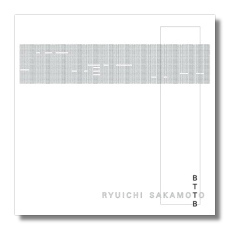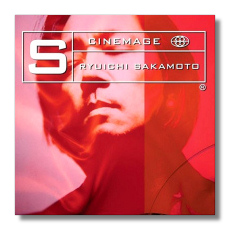
The Internet's Premier Classical Music Source
Related Links
- Latest Reviews
- More Reviews
-
By Composer
-
Collections
DVD & Blu-ray
Books
Concert Reviews
Articles/Interviews
Software
Audio
Search Amazon
Recommended Links
Site News
 CD Review
CD Review
Ryuichi Sakamoto

BTTB - Back to the Basics
- Energy Flow
- Put Your Hands Up
- Railroad Man
- Opus
- Sonatine for Piano
- Intermezzo
- Lorenz and Watson
- Chorals #1 & 2
- Bachata
- Chanson
- Prelude for Piano
- Uetax
- Aqua
- Tong Poo
- Reversing
Ryuichi Sakamoto, piano
Sony Classical SK89079 DDD 63:06


Cinemage
- Forbidden Colours
- The Last Emperor
- Little Buddha
- Wuthering Heights
- Replica
- El Mar Mediterrani
Ryuichi Sakamoto, Yutaka Sado, conductors
Sony Classical SK60780 DDD 48:02
Born in 1952, Ryuichi Sakamoto studied electronic music and formed the band Yellow Magic Orchestra in the late 1970s. Although it received scant attention in the United States, YMO was very popular in Asia for its cheerful electronic confections, which were as easy to dance to as licking on a lollipop. Also devoted to world music, Sakamoto has been a collaborator with artists as diverse as Youssou N'Dour and Iggy Pop. He is in demand for film score projects, and he's even a good actor: American audiences may have seen his performance in Merry Christmas, Mr. Lawrence, where he starred with David Bowie and Tom Conti.
BTTB (Back to the Basics) is a collection of 16 piano solos. As the name suggests, these solos are uncomplicated, offering neither great challenges to the listener nor to the performer. In fact, most semi-talented amateurs could get their fingers around the notes. That's fine; no one said good music needs to raise a sweat.
The first several pieces on this CD are pleasant piano pop, somewhat in the style of a hipper George Winston. The fourth piece ("Opus") injects French impressionist harmonies, and the rich textures of the more agitated sixth piece ("Intermezzo") prepare the listener for the remainder of the disc, which is more ambitious. "Lorenz and Watson" has the knowing naïveté of Erik Satie, and another French composer – Claude Debussy – seems to have inspired a piece titled "Bachata." There are two chromatic chorales (here identified as "Chorals"), and a "Chanson" – appropriately French and delicate, and gaily melancholy, if I may be permitted the paradox. Sakamoto evokes John Cage with a prepared piano "Prélude," which is notable for its mysterious gamelan-like feel. After some odd water noises, the program veers back to appealingly New Agey pop with "Aqua," followed by "Tong Poo." The latter is a peppy, catchy tune from Sakamoto's YMO years, and it works surprisingly well as a solo piano piece. The disc ends with "Reversing," a study in ringing chords with a minimalist flavor. Sakamoto is well up to the slight technical demands of his music; only "Tong Poo" would frighten a pianist with merely everyday proficiency. This program was recorded in Tokyo on a Yamaha piano. The sound is good, although the piano tone is a little hard.
Cinemage consists of music from films, and pieces for special occasions. The booklet notes don't share information about the source of these recordings. They seem not to be soundtrack recordings, and there are hints of audience noises and other live phenomena, yet neither date nor venue are identified.
It's a short CD. Sakamoto's range as a composer is clear from its contents, however. The song "Forbidden Colors" from Merry Christmas, Mr. Lawrence must be the composer's "greatest hit." An allusion to Mishima, I suppose, its affecting lyrics and powerful, Japanese-style melody create a mood of almost masochistic passion. David Bowie clone David Sylvian (singer for the group Japan) sings it here, as he did on the soundtrack album, but this is a more acoustic arrangement than any I've heard before. The Last Emperor builds a wistful Chinese tune (or is it the composer's?) to a tragic climax. Asian elements are less prominent in Little Buddha, which sounds like a conflation of Barber's Adagio for Strings, Ravel's Pavane for a Dead Princess, and the slow movement of Shostakovich's Fifth Symphony. For Wuthering Heights, Sakamoto launches a string cluster attack worthy of Penderecki's Threnody for the Victims of Hiroshima, but he soon settles into a more traditionally melancholy vein. These last two tracks are scored almost exclusively for strings.
Replica (apparently not associated with the movie of the same name) is multi-layered and more unsettled. Melodic figures are treated circularly, giving the piece a minimalist sound. This is an orchestration of piece that Sakamoto wrote for solo keyboard.
The first five selections on Cinemage last between about five and nine minutes. El Mar Mediterrani is a 17-minute suite of sorts. It wasn't until after I heard it several times that I read that Sakamoto wrote it for the opening ceremony of the 1992 Olympic Games in Barcelona; I thought it was the soundtrack to a horror film. Much of it is menacing: there are pounding rhythms, distorted and otherworldly choirs, and an seemingly psychotic attack on the piano keyboard. (There are hints of Ravel's music for Daphnis and Chloé, too.) It goes from mood to mood quickly and with no predictability whatsoever. DJ Spooky assists with percussive turntable stylings. It ends positively with a "sun rising over Asia" effect and a typically Sakamoto-like rising melody.
Cinemage is an interesting review of the composer's post-YMO work. I just wish that the documentation were better.
Copyright © 2000, Raymond Tuttle




















